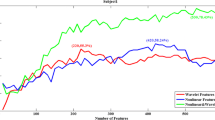Abstract
We studied the characteristics of evoked potentials recorded during the recognition test based on four types of series of images subjected to the wavelet filtration: images of living objects containing either low frequency or high frequency portion of the spatial frequency spectrum, and imaging of non-living objects in the same two spatial frequency bands. Each subject had to classify the image either by its semantic feature (living–non-living), or by its physical feature (low frequency–high frequency). The purpose of this study was to compare the time characteristics of evoked potentials in these two types of tasks, which provides information on the time characteristics of categorization mechanisms of visual images. Analysis of the latent periods and amplitudes of the components of evoked potentials allowed us to detect the occipital areas of the leads where the early components (up to 170 ms) are associated with spatial and frequency characteristics of the image, the frontal and temporal areas where the components of 170–200 ms correspond to the process of categorization, and the later frontal, central, and parietal areas (300–500 ms) correspond to the process of error detection and the organization of motor response.
Similar content being viewed by others
References
Viola, P. and Jones, M., Robust real-time object detection, in Second International Workshop on Statistical and Computational Theories of Vision: Modeling, Learning, Computing, and Sampling, Vancouver, 2001.
Lowe, D. G., Object recognition from local scaleinvariant features, in Proc. Int. Conf. on Computer Vision, 1999, pp. 1150–1157.
Shelepin, Yu. E., Chikhman, V. N., and Foreman, N., Analysis of the studies of the perception of fragmented images global description and perception using local features, Neurosci. Behav. Physiol., 2009, vol. 39, no. 6, pp. 569–580.
Lamminpiya, A.M., Vakhrameeva, O.A., Right, D.V., et al., Effect of wavelet filtering texts on eye movements in reading, Sens. Sist., 2013, vol. 27, no. 1, p. 3.
Moiseenko, G.A., Shelepin, Yu.E., Kharauzov, A.K., et al., Classification and recognition of images of animate and inanimate objects, J. Opt. Technol., 2015, vol. 82, no. 10, p. 685.
Keil, A., Debener, S., Gration, G., et al., Committee report: publication guidelines and recommendations for studies using electroencephalography and magnetoencephalography, Psychophysiology, 2014, vol. 51, no. 1, p. 1.
Schiller, P., Parallel information processing channels created in the retina, Proc. Natl. Acad. Sci. U. S. A., 2010, vol. 107, no. 40, p. 17087.
Maunsell, J., Geoffrey, M., Ghouse, J.A., et al., Visual response latencies of magnocellular and parvocellular LGN neurons in macaque monkeys, Vis. Neurosci., 1999, vol. 16, no. 1, p. 1.
Shevelev, I.A., Physiology of sensory systems. Part I. Physiology of vision, Rukovodstvo po fiziologii (Handbook of Physiology), Leningrad: Nauka, 1971.
Kaplan, E., The M,P and K pathways of the Primate Visual System revisited, in The New Visual Neuroscience, MIT Press, 2014, p. 1.
Logunova, E.V., Britikov, A.A., Shabalina, N.A., et al., Investigation of the safety of the visual environment, Biotekhnosfera, 2014, nos. 1–2 (31–32), p. 24.
Logunova, E.V. and Shelepin, Yu.E., Study of the role of spatial-frequency filtering of images when evaluating the age and interpreting the emotional expression of faces, J. Opt. Technol., 2015, vol. 82, no. 10, p. 694.
Shelepin, Yu.E., Fokin, V.A., Harauzov, A.K., et al., Location of the decision-making centre during image shape perception, Dokl. Biol. Sci., 2009, vol. 429, p. 511.
Polich, J., Updating P300: an Integrative Theory of P3a and P3b, Clin. Neurophysiol., 2007, vol. 118, no. 10, p. 2128.
Moiseenko, G.A., Harauzov, A.K., Pronin, S.V., et al., Human brain evoked potentials to the animate and inanimate nature objects images, in Data Processing in EEG/MEG (Proc. Methodol. School, Moscow, Apr. 16–30, 2013), Moscow, 2013, p. 32.
Moiseenko, G.A., The role of instruction in classification tasks of one alphabet of images based on physical characteristics and semantic meaning, Proc. 6th Int. Conference on Cognitive Science, Apr. 23–27, 2004, Kaliningrad, 2004, p. 715.
Moiseenko, G.A., Kharauzov, A.K., Pronin, S.V., et al., Influence of the wavelet filtration of images on spatial-temporal localization of the process of categorization and making solutions, in Applied Optics–2014 (Proc. XI Int. Conference, St. Petersburg Oct. 21–24, 2014), St. Petersburg, 2014.
Shelepin, Yu.E., Kharauzov, A.K., Pronin, S.V., et al., Using neuroimaging methods to localize mechanisms for making decisions concerning the ordering of textures, J. Opt. Technol., vol. 78, no. 12, p 808.
Pitts, M.A., Padwal, J., Fennelly, D., et al., Gamma band activity and the P3 reflect post-perceptual processes, not visual awareness, NeuroImage, 2014, vol. 101, p. 337.
Hochstein, S. and Ahissar, M., View from the top: hierarchies and reverse hierarchies in the visual system, Neuron, 2002, vol. 36, no. 5, p. 791.
Author information
Authors and Affiliations
Corresponding author
Additional information
Original Russian Text © G.A. Moiseenko, E.A. Vershinina, S.V. Pronin, V.N. Chihman, E.S. Mikhailova, Yu.E. Shelepin, 2016, published in Fiziologiya Cheloveka, 2016, Vol. 42, No. 6, pp. 37–48.
Rights and permissions
About this article
Cite this article
Moiseenko, G.A., Vershinina, E.A., Pronin, S.V. et al. Latency of evoked potentials in the tasks involving classification of images after wavelet filtration. Hum Physiol 42, 615–625 (2016). https://doi.org/10.1134/S0362119716060128
Received:
Published:
Issue Date:
DOI: https://doi.org/10.1134/S0362119716060128




